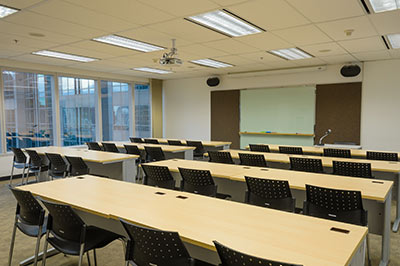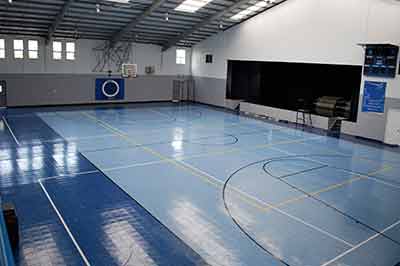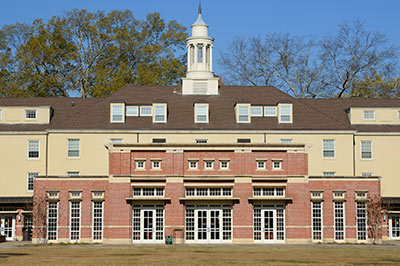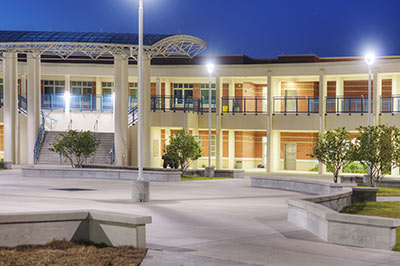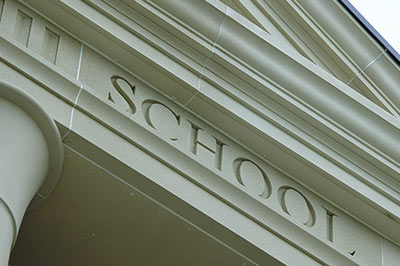Ethan Lott (2014). Since the Pittsburgh Business Times published its first list of area LEED-certified "green" buildings or projects, the region has continued to be a leader in green building, as more and more large area projects seek certification for being environmentally friendly. (Posted on August 1, 2014).
Tag: Green Schools
New building at George Washington University certified LEED platinum
Jill Nolin. (2014). George Washington University’s new Milken Institute School of Public Health has garnered the highest honor for its sustainability features. (Posted on July 22, 2014).
Permeable Concrete
Dawn Killough (2014). Permeable concrete (also called porous concrete, pervious concrete, no fines concrete and porous pavement) is a special type of concrete with a high porosity that allows water from precipitation and other sources to pass directly through, thereby reducing the runoff from a site and allowing groundwater recharge. (Posted on July 15, 2014).
An Examination of Green School Practices in Atlanta Schools by Dr. TC Chan
 Chan, T. C. (2013). The primary goal of the study was to examine green environmental practices exercised in maintaining healthy schools in Atlanta. A forty item researcher developed instrument was used to survey 30 randomly sampled schools in the Atlanta area. Analysis did not find any relationship between green school implementation and school building age, school ethnicity, and socioeconomic status of school communities. Dr. Chan noted: "Recognizing the importance of green school programs to the future generation, school leaders need to commit themselves to establishing green school development policies, adopting sustainable school designs, initiating substantial green school operating practices, and developing educational programs to promote green school concepts. School leaders have a major responsibility in turning our schools green.
Chan, T. C. (2013). The primary goal of the study was to examine green environmental practices exercised in maintaining healthy schools in Atlanta. A forty item researcher developed instrument was used to survey 30 randomly sampled schools in the Atlanta area. Analysis did not find any relationship between green school implementation and school building age, school ethnicity, and socioeconomic status of school communities. Dr. Chan noted: "Recognizing the importance of green school programs to the future generation, school leaders need to commit themselves to establishing green school development policies, adopting sustainable school designs, initiating substantial green school operating practices, and developing educational programs to promote green school concepts. School leaders have a major responsibility in turning our schools green.
Keywords: green school, school environment, resource conservation, school facility planning, school renovation, school maintenance, school sustainability
A Case for Schoolhouse Aesthetics by Charles Kenneth Tanner
 Tanner, C. K. (2013). Dr. Tanner conducted his research about new learning environments being built and took into consideration numerous variables. For example, school systems consider the instructional needs of the students they serve, enrollment, and whether to replace or remodel an old building. The concept of “going green” encourages school system planners to consider the natural surroundings and built environment that surrounds the school, thereby allowing the school's architecture to match its surroundings. This notion has sparked an interest in sustainable design, which may best be explained as minimizing the harmful effects of the building on the environment. It further extends to the theory of biophilia or a natural attraction to living systems. Sustainability and the biophilia premise go far beyond just following new codes for construction and materials related to Leadership in Energy and Environmental Design certification. They link directly to aesthetics.
Tanner, C. K. (2013). Dr. Tanner conducted his research about new learning environments being built and took into consideration numerous variables. For example, school systems consider the instructional needs of the students they serve, enrollment, and whether to replace or remodel an old building. The concept of “going green” encourages school system planners to consider the natural surroundings and built environment that surrounds the school, thereby allowing the school's architecture to match its surroundings. This notion has sparked an interest in sustainable design, which may best be explained as minimizing the harmful effects of the building on the environment. It further extends to the theory of biophilia or a natural attraction to living systems. Sustainability and the biophilia premise go far beyond just following new codes for construction and materials related to Leadership in Energy and Environmental Design certification. They link directly to aesthetics.
C. Kenneth Tanner, Professor of Career and Information Studies, University of Georgia, Athens, is a graduate of Florida State University. He teaches graduate courses in educational planning, policy, and organizational studies. His research chain takes into consideration how the physical environment influences behavior and productivity. Most recently, he is working on comparing student productivity in "green" schools, and is consultant to both public and private schools that are planning educational facilities. Dr. Tanner has published and presented over 150 articles, book chapters, and academic papers. He is the primary author of four textbooks and his most recent book on educational facilities planning and design is among the best selling works in the areas of academic and applied studies of school facility planning.
Towards Healthy Schools 2015 – Progress on America’s Environmental Health Crisis for Children
Coalition for Healthier Schools (2015).
Towards Healthy Schools 2015: Progress on America’s Environmental Health Crisis for Children is the third triennial state-by-state data and policy report on this topic since 2006. Sick Schools (2009) and before it Lessons Learned (2006) researched and assessed state-by-state data and policies on environmental conditions at schools and risks to children’s health, compiling them into a single, unique resource that painted a deeply disturbing picture, in which vulnerable children endure unhealthy schools. This guide provides basic federal data for public schools, such as total number of buildings; total enrollment; total number of personnel; percentage of children with asthma; percentage of children without health insurance; total number of children receiving special education; total number of children of minority status; and more.
LEED Stories from Practice Article – Quantifying Sustainabilty
U.S. Green Buiilding Council (2013).
The value of sustainability must analyze the costs to design, construct and, operate and maintain a green building offset by the building’s long-term energy and operating savings.The innovative LEED projects detailed illustrate how a focus on sustainability adds value. Even though standardized methods do not yet exist to quantify important benefits, the hope is that the marketplace will soon respond, providing a way to truly reflect the value of green building.
Financing campus sustainability in Georgia
National Wildlife Federation (2012).
National Wildlife Federation hosted a multi-speaker webinar which emphasized various approaches across the State of Georgia, at institutions of higher education, to implement sustainable design practices (e.g. green fees at the University of Georgia).
Sustainable design in a historic school – A case study of Woodrow Wilson High School
Wilson, A. D., Ortiz, H., Dorris, D., Whetstine, L., Royal, M., & Atkinson, H. (2012).
In this case study, Woodrow Wilson High School is highlighted for its commitment to transform the facilities’ learning environment using sustainable design practices in a historic school. Sustainable design features of Woodrow Wilson High School include: an atrium dish skylight with purposeful piping design to capture rainwater for use within the facility, a storm water management system (one 15,000-gallon cistern and one 30,000-gallon storm water filtration system), an innovative roof space with native landscaping, and adaptive reuse areas within the modernized facility.
Designing Sustainable Schools – The Emergent Role of Superintendent as Sensemaker
Klocko, B. A. (2012). 3 (1)
The impact of the superintendent in the design decision-making process of sustainable school buildings was examined in this case study analysis of the attitudes and influences of superintendents in six Midwestern school districts that engaged in construction projects during the previous five years. The major findings of this study are: (a) Leadership is the key to greening America’s schoolhouses; (b) Superintendents are inadequately prepared for dealing with issues regarding sustainability; (c) Superintendents who utilized sensemaking as a decision-making strategy yielded high-quality decisions; and (d) Superintendents who could articulate a vision of triple bottom line sustainability which incorporated the environmental, educational, and economic principles of sustainability were viewed by constituents as effective stewards. This purposeful sampling provided rich data to support three distinct motivations for building green—social or educational, environmental, and economic. Today, superintendents mindful of the triple bottom line regarding sustainability are leading the way toward a sustainable future.


